Archive for the ‘cup/saucer’ Category
Sunday, July 5th, 2015
This cup is a mess! It’s a 2.5 inch high Chinese porcelain cup from the Qianlong period (1736-1795) with multi-color enamel decoration in the Mandarin style. Well over 150 years ago when it dropped and shattered into 12 pieces, it was most likely taken to an itinerant “dish mender” who carefully applied 15 metal staples to bring it back to life. A bit of plaster was used to fill in a few gaps left by lost fragments. Past owners really must have cherished this little mug, as it managed to survive many centuries looking like this. As my grandmother would have said, “Oy Vey!”
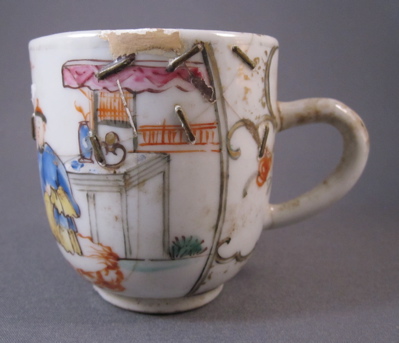
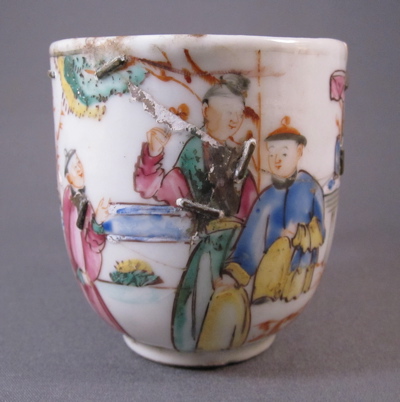
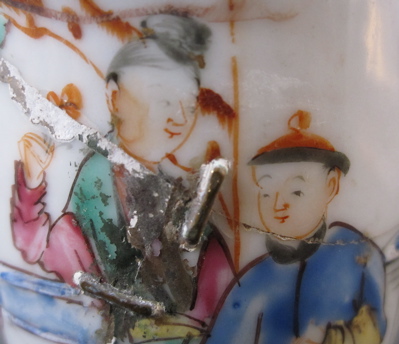
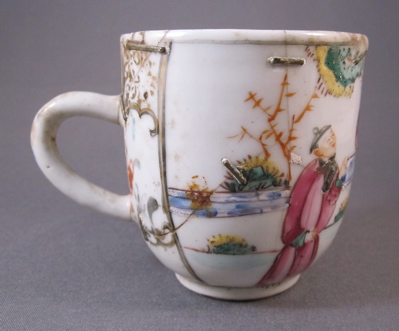

This cup, in much better condition than mine, shows what an intact example looks like.
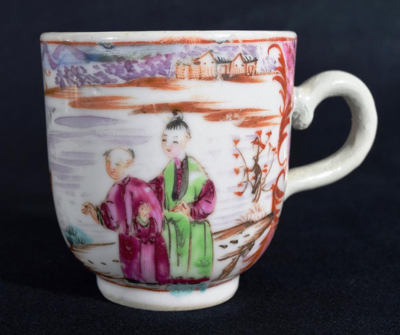
Photo courtesy of eBay
Tags:Chinese, Mandarin, porcelain, staples/rivets
Posted in cup/saucer | No Comments »
Sunday, December 21st, 2014
Wishing you all the best during the holiday season and for a healthy and Happy New Year!
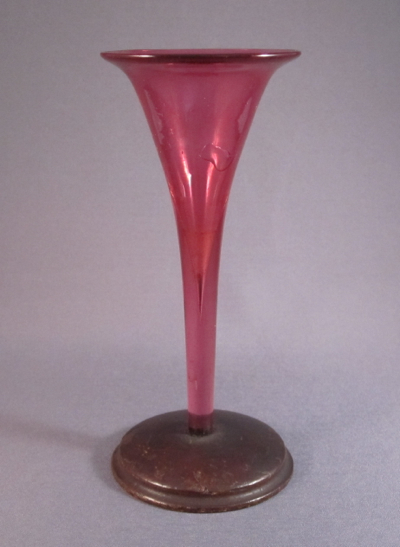
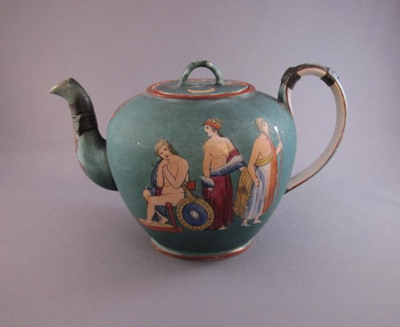
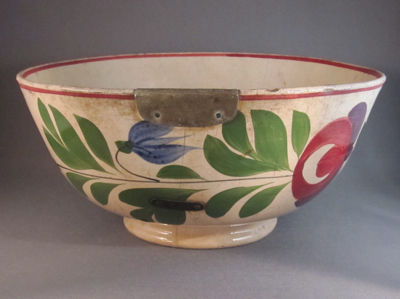
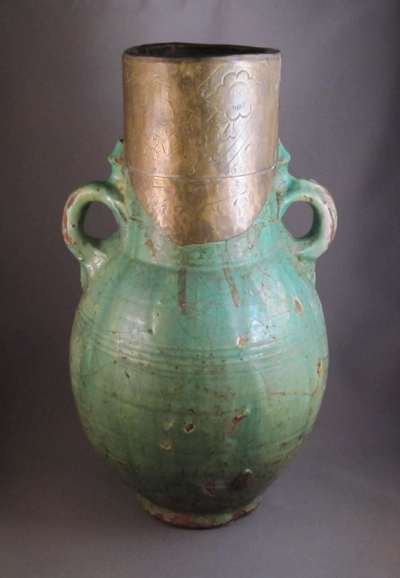
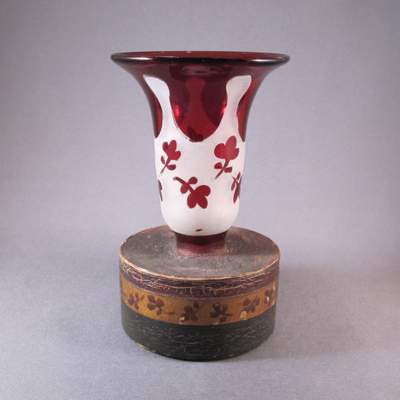
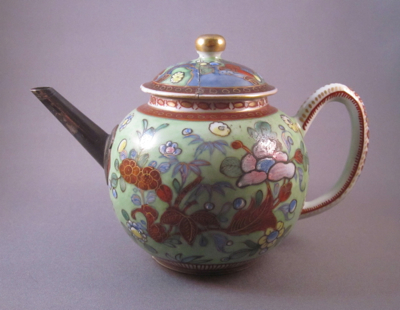
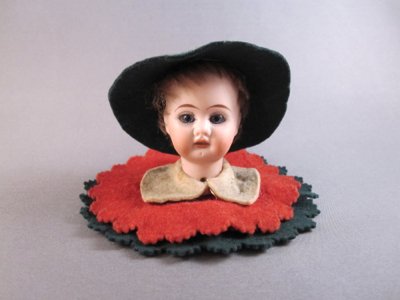
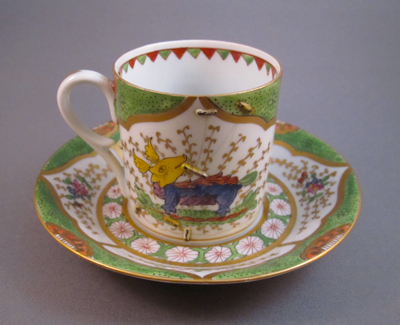
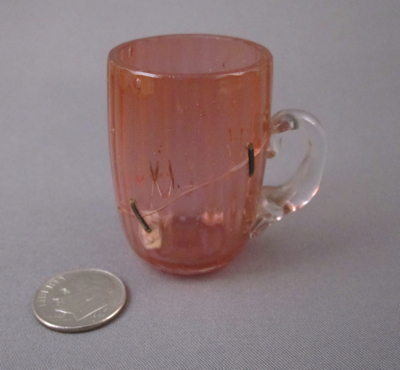
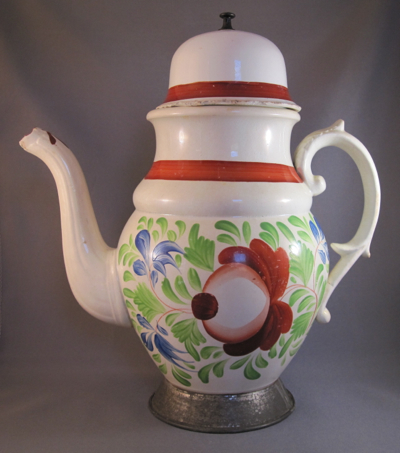
Tags:Chinese, clobbered, English, German, glass, globular, metal base, miniature, porcelain, pottery, silver, staples/rivets, wood base
Posted in bowl/dish, chocolate/coffee pot, cup/saucer, jug, plate/platter, teapot, toy, vase/vessel | 8 Comments »
Sunday, December 14th, 2014
This handsome porcelain cup was made in England by Spode, circa 1820. It is decorated with a bat printed pastoral scene of a person approaching a cottage, with gilt trim at top and bottom. It measures 2-1/4″ high, with an opening of 3-1/4″.
At some point in the 1800s the cup was dropped and broke into three pieces. A china mender with a steady hand used eight tiny brass staples to hold the cup back together.
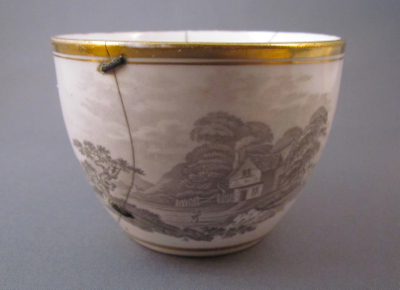
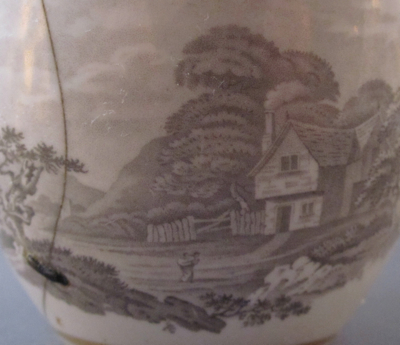
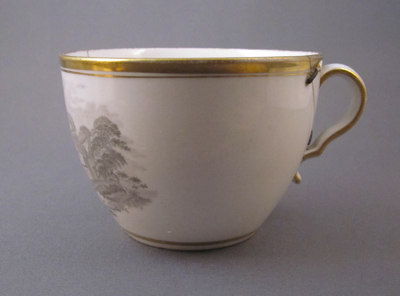
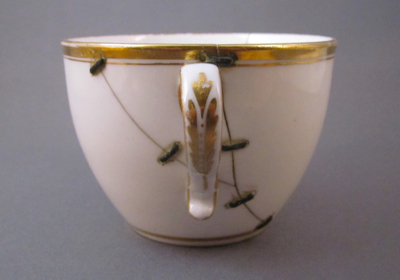
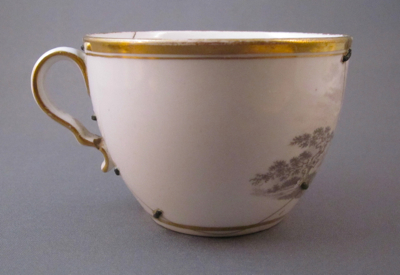
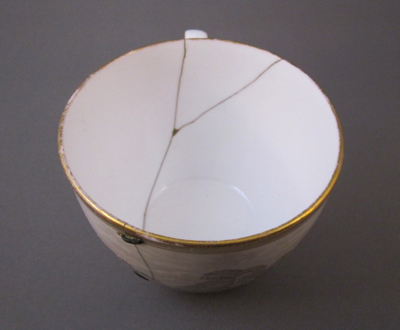
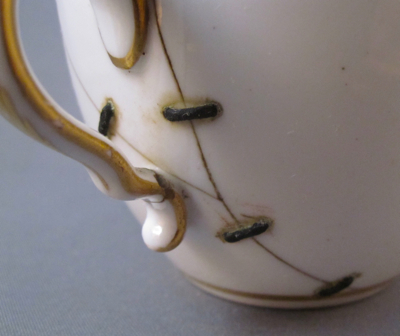
Tags:English, porcelain, staples/rivets, transferware
Posted in cup/saucer | 1 Comment »
Saturday, October 4th, 2014
This delicate English porcelain bone china cup and saucer each have a transfer decoration of butterflies and flowers with hand painted washes of color. The figural butterfly handle, though lovely to look at, makes for an unsteady grasp on a steaming hot cup of tea. Perhaps that’s how both the cup and the saucer met their early demise and ended up crashing to the floor, breaking into many pieces. But luckily a local china mender was standing by with drill and staples at hand, and able to join together the broken pieces. Six tiny brass staples were carefully attached, three on the cup and three on the saucer, allowing the tea to flow once more.
Marked on the underside of the cup, which measures 1-3/4″ high, is an English registry cypher, dating the piece to April 7, 1869. The saucer, with a diameter of 5-1/2″, has a faint impressed MINTON mark.
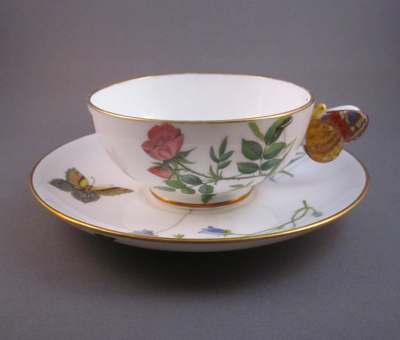
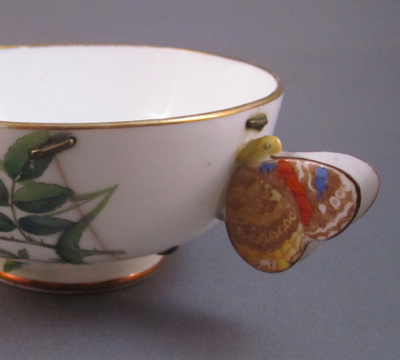
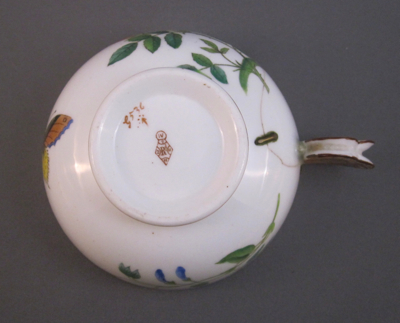
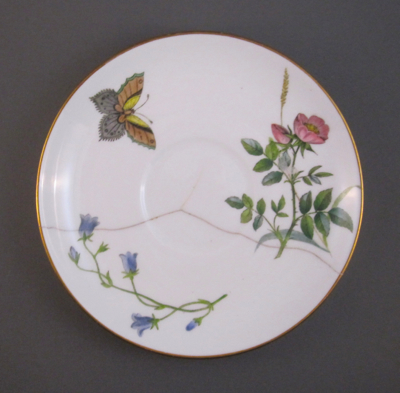
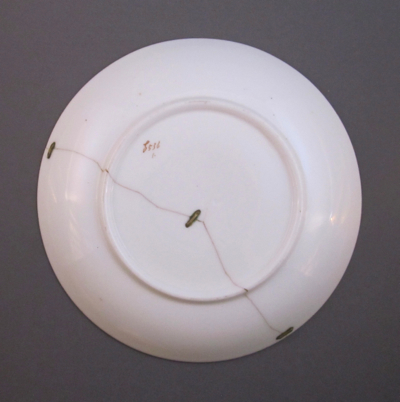
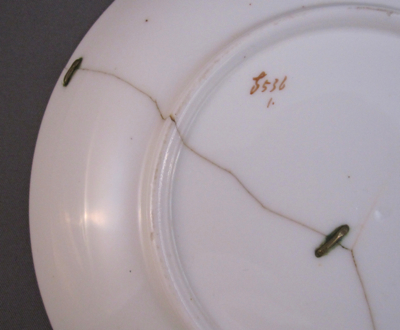
Tags:English, porcelain, staples/rivets, transferware
Posted in cup/saucer, saucer | Comments Closed
Sunday, September 7th, 2014
This colorful Chinese porcelain London shape tea cup dates from 1820-1850 and is decorated in the Canton rose palette. It measures 2-1/2″ high and has an opening diameter of 3-1/4″ . The outer polychrome enamel Mandarin decoration depicts a scene of scholars in a garden, and the inside of the rim has a deep painted border of dragons with small stylized clouds. This cup was originally a part of a large dinner service, custom ordered by most likely a wealthy English family.
At some point in the early life of the cup, the original porcelain handle snapped off. But rather than simply toss out the damaged goods as we would today, it was brought to a metalsmith, who fashioned a bronze replacement handle in the same form as the original. To me, the dark color and sculptural quality of the replacement handle makes this embellished cup much more interesting than its “perfect” counterpart.
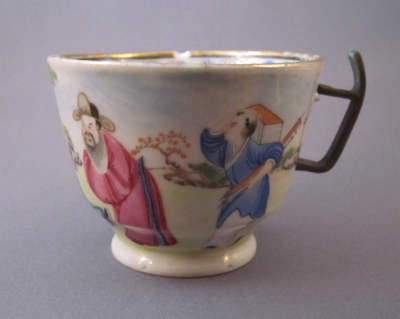
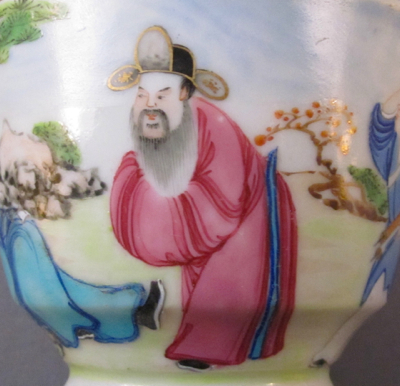
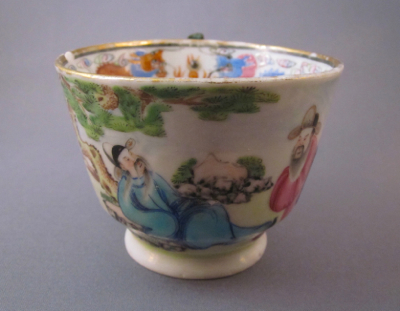
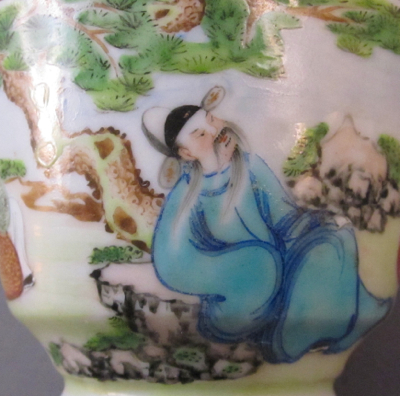
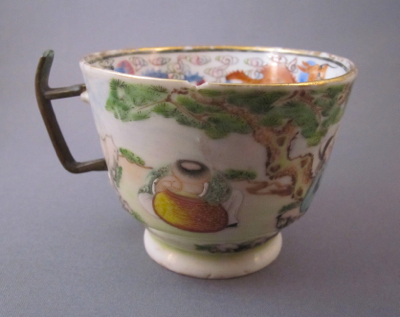
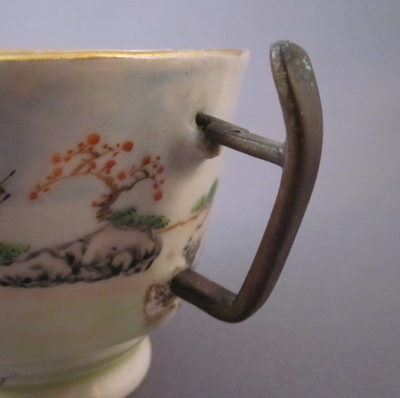
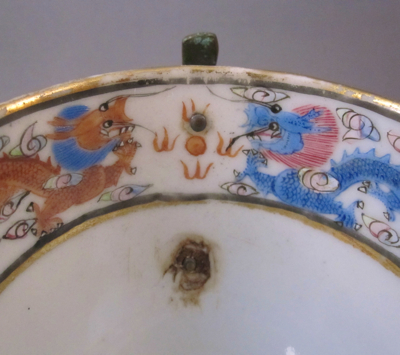
This tea cup still has its original handle intact.
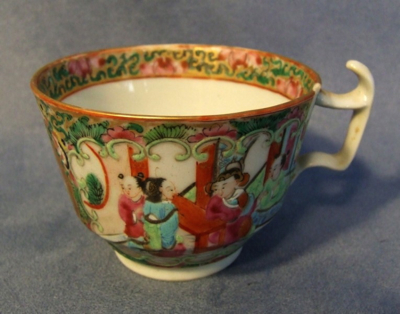
Photo courtesy of Hundred & One Antiques
Tags:Chinese, Mandarin, metal handle, porcelain
Posted in cup/saucer | 3 Comments »
Saturday, July 26th, 2014
In the world of collecting, nothing pleases me more than stumbling upon items with matching inventive repairs, and this set of footed breakfast cups and saucers deliver five times over. Made in England by Mason’s Ironstone from 1830 to 1840, these heavy porcelain cups, measuring nearly 3-1/4″ tall, have the transfer printed “Conversation” pattern in the rare yellow scale colorway. Each cup and saucer is marked in black transfer on the underside MASON’S PATENT IRONSTONE CHINA.
I purchased the set during my last trip to London from dealer Fergus Robert Downey who later told me that he has a sixth cup with an identical replaced handle, so I am hoping to one day have the complete sextet. I can’t imagine that all of the original handles snapped off the cups at the same time, unless a particular breakfast got a bit too rowdy. More likely, one or two handles might have broken off, so in order to keep the set looking uniform, the remaining intact handles were removed and all cups were fitted with the same metal replacement. The metalsmith did a fine job, as all of the handles are well matched and expertly riveted to the cups.
Now about that sixth cup, Fergus… 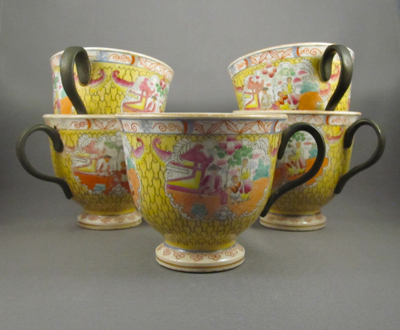
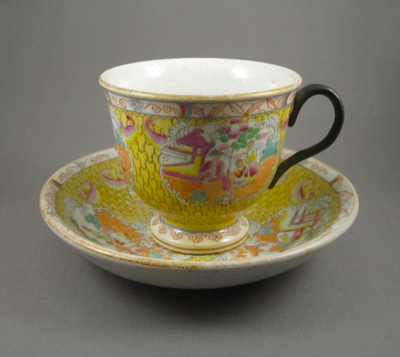
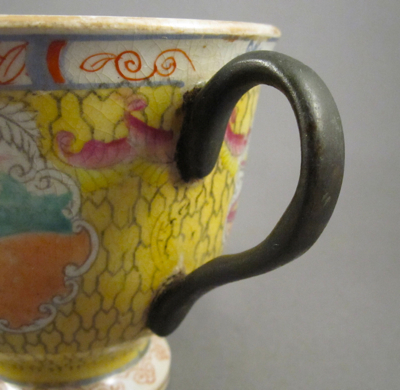
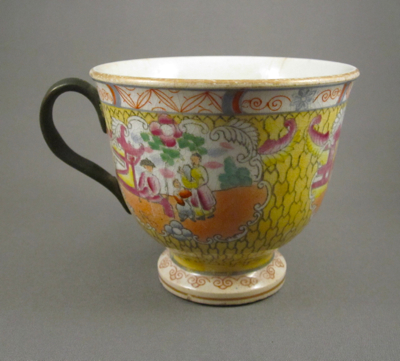
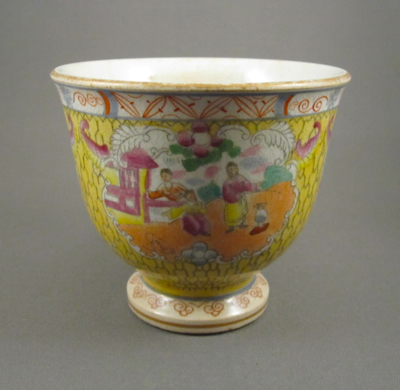
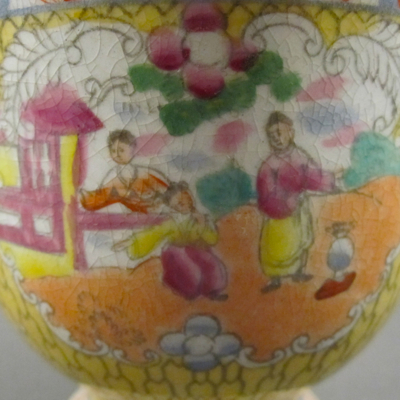
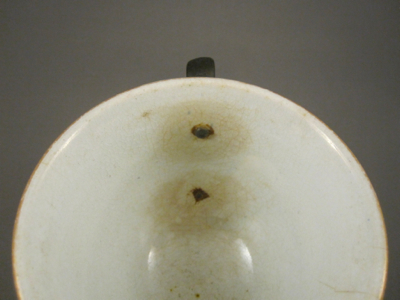
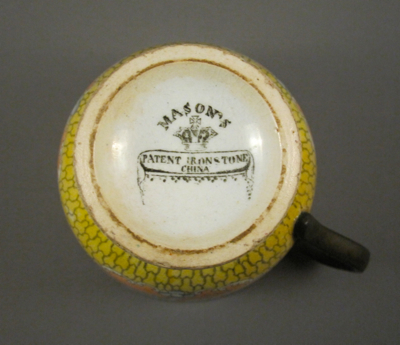
This cup, in perfect condition, shows what the original handles on my cups would have looked like before they took a tumble.
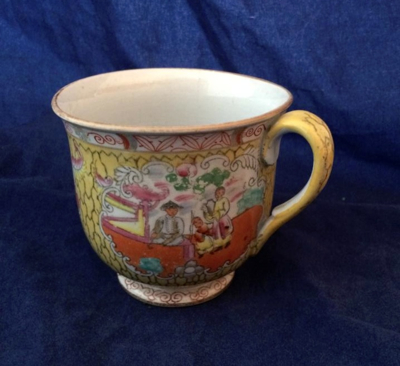
Photo courtesy of Vanbrugh West Antiques
Tags:bronze, English, metal handle, porcelain
Posted in cup/saucer | 8 Comments »
Saturday, May 17th, 2014
This minute bone china porcelain cup & saucer duo, made at the turn of the 20th century at the Coalport factory in Shropshire, England, has some of the smallest metal staple repairs I have ever seen. It has printed Japanese style floral decoration in the Japanese Imari palette, consisting of iron red, cobalt blue and gilt enamels. Both pieces are marked with a green stamp on the underside, dating them to 1890-1920. The saucer measures 3-1/4″ in diameter and the cup stands nearly 1-1/2″ high with an opening of 2″.
After the dainty saucer fell to the floor, breaking into six small fragments, it was brought to a china mender who pieced the puzzle back together. Using 10 custom made metal staples, the smallest being a mere 1/4″ long, the saucer was once again able to function as a support to the tiny cup it carried. Imagine the nimble fingers capable of creating such fine work!
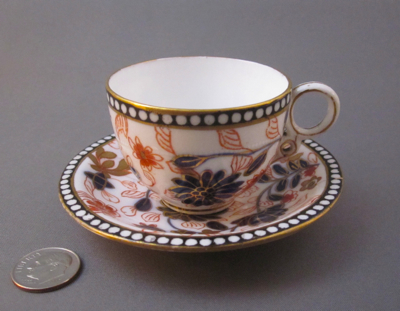
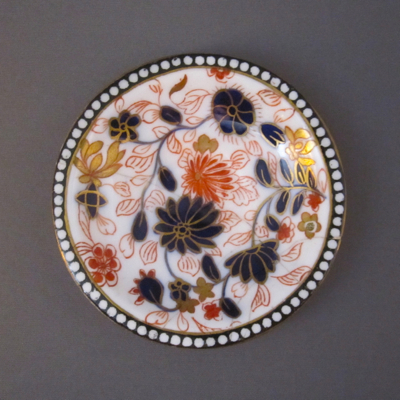
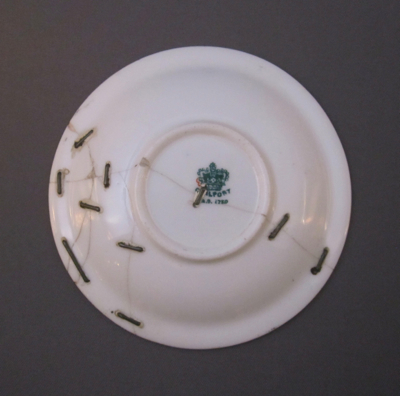
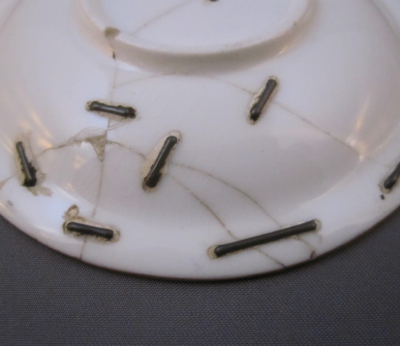
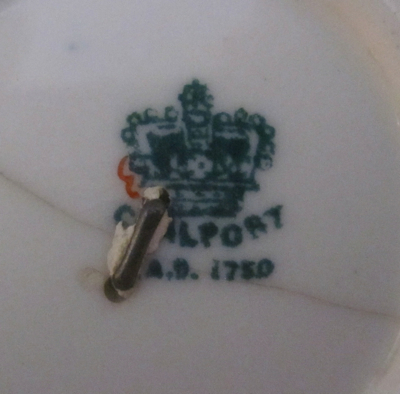
Tags:English, Imari, miniature, porcelain, staples/rivets
Posted in cup/saucer, saucer | No Comments »
Saturday, March 15th, 2014
To celebrate the conclusion of my work on Season 2 of The Americans, a television show on the FX network set in 1982 about a pair of Russian spies living as Americans in Washington, D.C., I am posting this pair of Russian tea cups and saucers. They were made by the Gardner factory at the turn of the 20th century and are decorated with gold leaves, and hand painted flowers in white medallions, set against a deep red ground. They are part of a larger tea set, many of which were exported to the Turkish Empire and Central Asia. The cups measure about 2″ high, with an opening of 3-1/4″, and the saucers have a diameter of 5-1/4″. Both cups were broken and repaired by a china mender in the early to mid 1900s, after Sascha dropped the entire tea service while entertaining Anastasia and Vladimir. неуклюжая девочка!
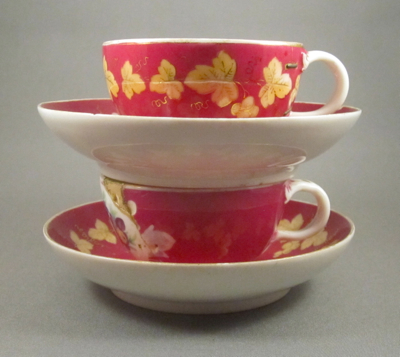
Cup 1 (top) with gilt leaf decoration, has hand cut metal staples that still hold the two broken pieces tightly together. It has a factory mark stamped in red on the underside.
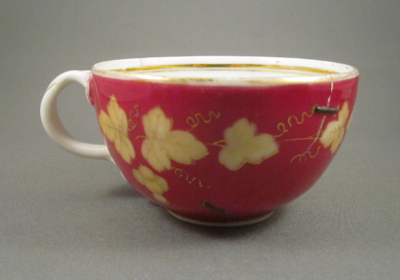
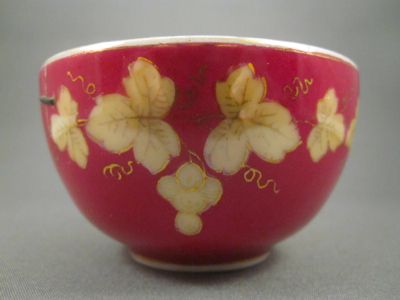
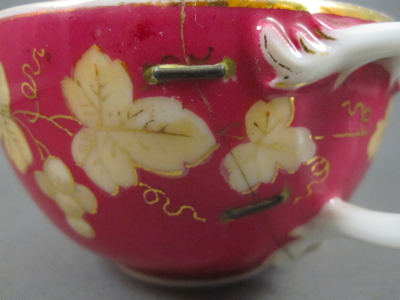
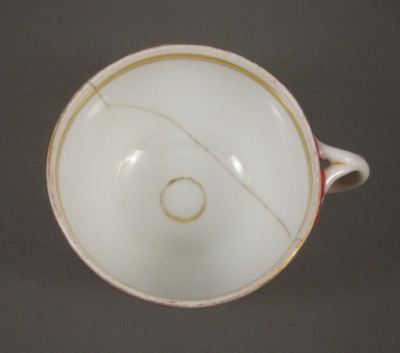
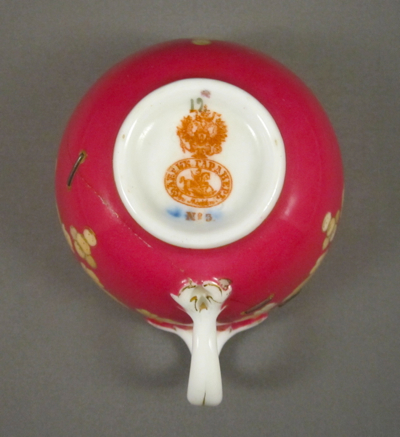
Cup 2 (bottom) has a yellowed replaced chip, possibly from another cup. Once repaired with metal staples, the cup is now held together by a sloppy glue job, although the empty staple holes are still visible.
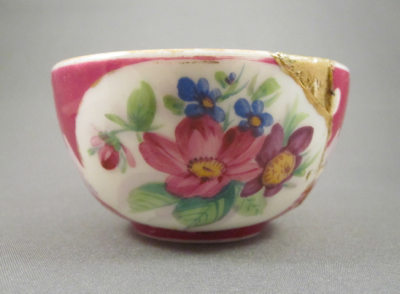
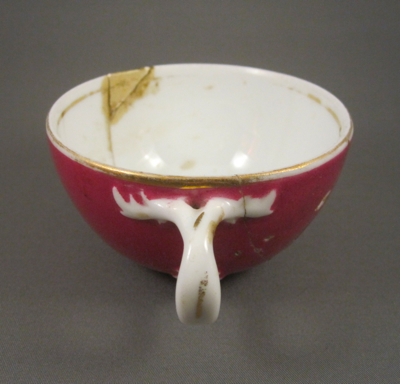
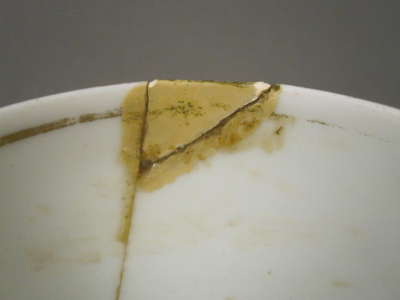
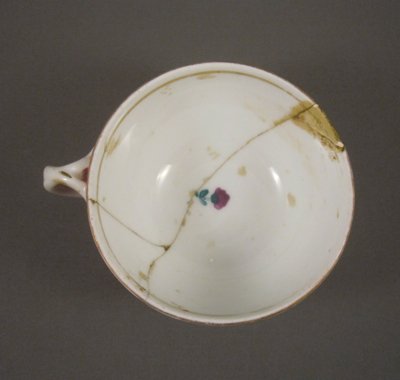
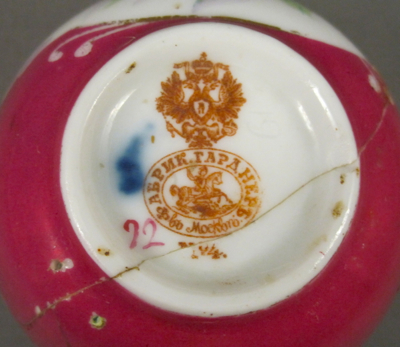
This partial tea set was also made by Gardner and includes a cup and saucer much like mine.
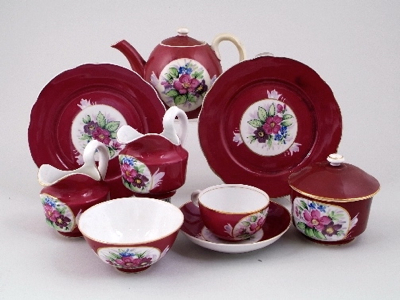
Photo courtesy of LiveAuctioneers
Tags:porcelain, Russian, staples/rivets
Posted in cup/saucer, saucer | No Comments »
Sunday, February 23rd, 2014
This beautifully painted three-handled porcelain tyg was made in Staffordshire, England by Cauldon, c.1905-20. It is hand painted in polychrome enamels with gilt detailing in the Highland Cattle pattern, signed D Birbeck. It is marked in green on the underside CAULDON LTD England and measures 7″ high, with an opening diameter of 5-1/4″.
Tygs are muli-handled drinking cups designed to be passed around and shared by many drinkers. The space on the rim between the handles delineates a surface for each drinker, a more sanitary solution to a single handled mug. Tygs date to the 15th century and were popular into the 17th century, but today they are used for decoration and the nasty old habit of sharing a beer in a traditional mug lives on.
We will never know if this fine tyg suffered its many breaks as a result of being thrown across the room during a bar brawl or if it merely slipped from grandma’s hands as she was dusting it. But thankfully it was brought to the attention of a china mender, who pieced the puzzle back together using 17 metal staples.
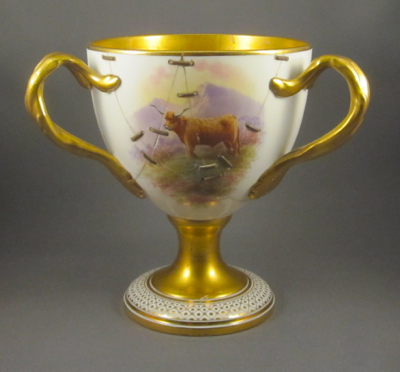
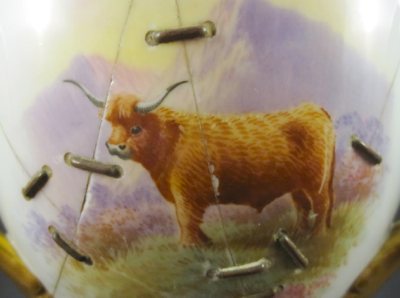
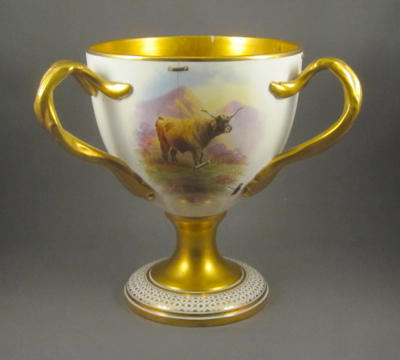
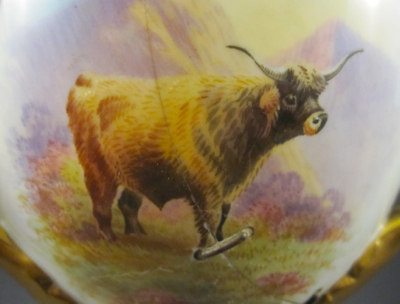
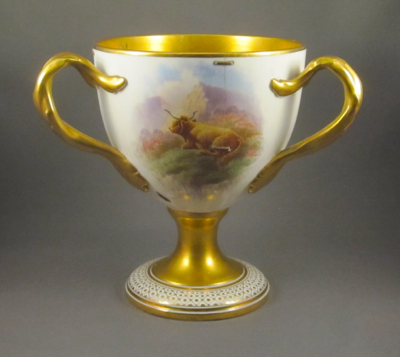
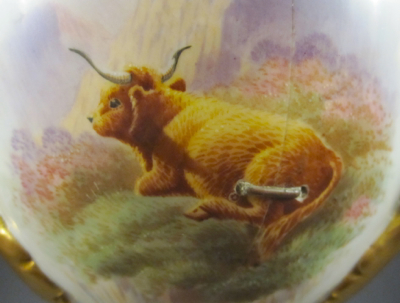
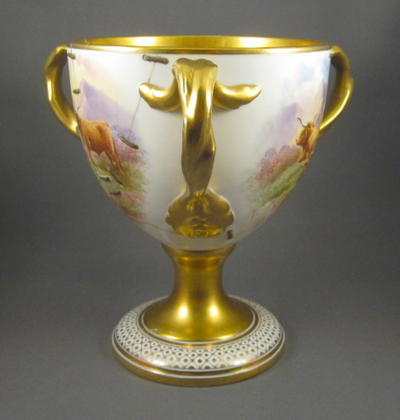
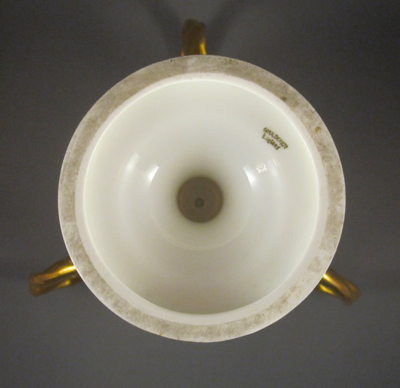
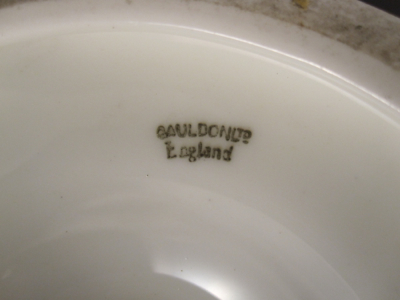
Tags:English, porcelain, staples/rivets
Posted in cup/saucer | 3 Comments »
Saturday, November 2nd, 2013
This colorful porcelain loving cup was made by the Paragon China Company in Stoke-on-Trent, England, in 1937 to commemorate the coronation of King George VI and Queen Elizabeth. The figural lion handles and pastel colors give it a distinctive Art Deco look. At first glance the cup appears to be in tip-top condition, but upon closer inspection you can see all is not perfect for the royal couple. I imagine that after a robust toasting to the King and Queen, the loving cup clanked against a large stoneware tankard and broke in half. Surprisingly, it was not glued back together but brought to a china repairer who applied metal staples to make it whole again. With the invention of new types of glues and cements, developed for use during World War II, civilians were doing their own repairs at home, so by the mid-20th century, traditional staple repairs were becoming obsolete.
It seems that the china repairer or the owner of the cup couldn’t leave well enough alone and tried to mask the repair by painting over the staples. They did a decent job, however, matching the colors of the mug as they painstakingly matched each brushstroke of the pattern beneath.
The broken cup has been restored…long live the King! Long live the Queen! Long live the Art of Inventive Repair!
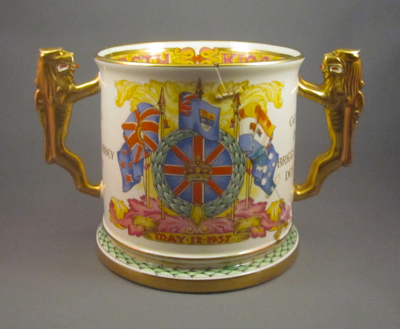
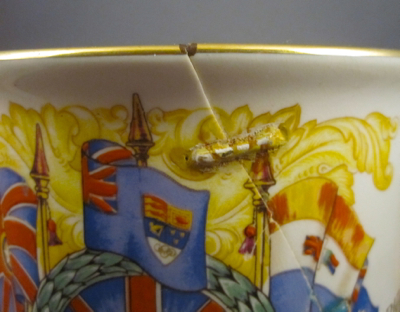
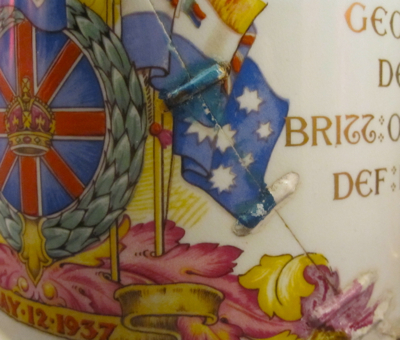
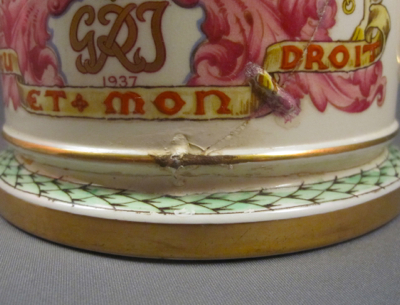
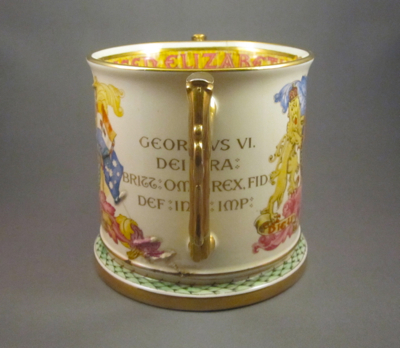
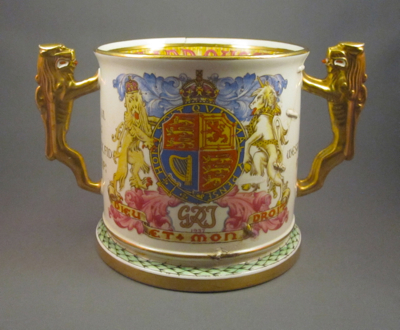
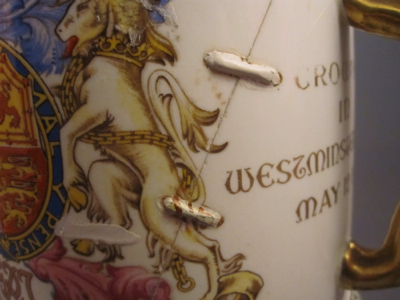
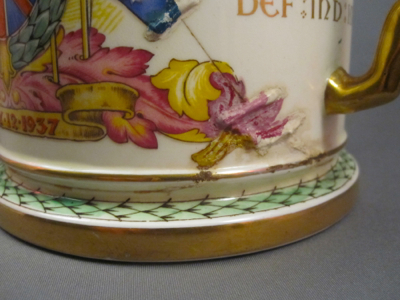
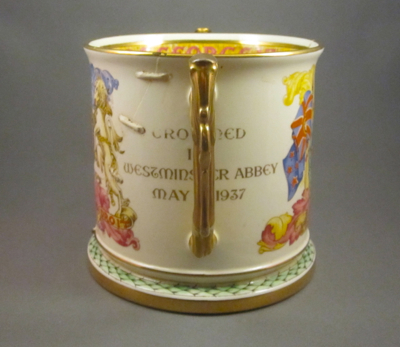
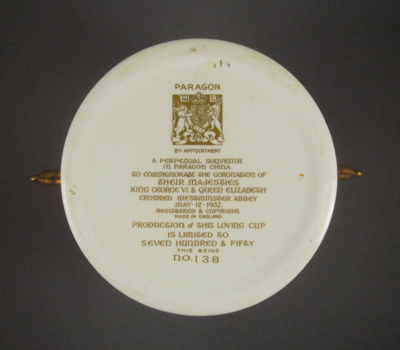
Tags:commemorative, English, porcelain, staples/rivets
Posted in cup/saucer | 4 Comments »

















































































